Reports
The IAEA’s Iran NPT Safeguards Report - May 2022
by David Albright, Sarah Burkhard, and Andrea Stricker [1]
June 2, 2022
“Unless and until Iran provides technically credible explanations…the Agency cannot confirm the correctness and completeness of Iran’s declarations under its Comprehensive Safeguards Agreement.” -International Atomic Energy Agency (IAEA) Director General Rafael M. Grossi
This analysis summarizes and assesses information in the latest IAEA’s periodic safeguards report, NPT (Nuclear Non-Proliferation Treaty) Safeguards Agreement with the Islamic Republic of Iran, the most recent of which was issued on May 30, 2022. It also provides background information on the former Iranian nuclear weapon sites under IAEA investigation.
For nearly four years, the IAEA has been investigating the presence of man-made uranium particles at three Iranian sites and, up until its last report, was seeking information about nuclear material and activities at a fourth site. For the first time since the IAEA began its investigation, it uses the actual names of the four sites – Turquz Abad, Varamin, Marivan, and Lavisan-Shian – rather than referring to them as Locations 1-4.
On March 5, 2022, the IAEA and Iran agreed to a timetable for Iran to provide the agency with information and explanations to clarify the IAEA’s discovery of man-made uranium particles at three sites. Under its legal nonproliferation obligations, Iran is bound to explain the activities that led to the use or production of this nuclear material. The IAEA notes that “it has provided Iran with numerous opportunities, in different formats through exchanges and meetings in Vienna and Tehran” to explain the findings, but to no avail.
In a stunning indictment of Iranian non-compliance with the NPT safeguards agreement, the IAEA’s report states, “Iran has not provided explanations that are technically credible in relation to the Agency’s findings at those locations. Nor has Iran informed the Agency of the current location(s) of the nuclear material and/or of the equipment contaminated with nuclear material, that was moved from Turquzabad in 2018. In addition, nuclear activities and nuclear material used therein at Lavisan-Shian were not declared by Iran to the Agency as required under Iran’s Comprehensive Safeguards Agreement.”
The IAEA, in essence, reports that Iran is in breach of the NPT and will remain so until it cooperates: “Until and unless Iran provides technically credible explanations for the presence of uranium particles of anthropogenic origin at Turquzabad, Varamin and ‘Marivan’ and informs the Agency of the current location(s) of the nuclear material and/or of the contaminated equipment, the Agency cannot confirm the correctness and completeness of Iran’s declarations under its Comprehensive Safeguards Agreement.”
The matter now moves to the IAEA’s 35-member Board of Governors, which next convenes from June 6 to 10. It is the duty of member states to officially determine Iran’s non-compliance with its safeguards agreement and pass a censure resolution demanding Iran’s cooperation with the IAEA. Since June 2020, the board has not passed a new resolution demanding Iran’s cooperation and compliance, even in the face of ongoing, threatening nuclear advances by Tehran. If member states do not act, the international community will send a signal to Iran, as well as other would-be proliferant states, that it will tolerate NPT violations. This will undermine the IAEA’s authority, lead to the NPT’s degradation, and other states seeking nuclear weapons.
IAEA/Atomic Energy Organization of Iran (AEOI) Joint Statement
On March 5, following a visit by IAEA Director General Rafael Grossi to Tehran, the IAEA and the AEOI released a Joint Statement to “accelerate and strengthen their cooperation and dialogue aimed at the resolution of [outstanding] issues.” The agreement aimed to resolve by the June 2022 board meeting the IAEA’s remaining questions about three undeclared Iranian sites where it found man-made uranium in 2019 and 2020. In a marked difference from the workplan leading up to the implementation of the 2015 nuclear deal, the Joint Comprehensive Plan of Action (JCPOA), the agreement did not commit the IAEA to “close” its investigation or satisfy itself with a series of joint meetings and false Iranian statements or declarations.
The IAEA reports that pursuant to the agreed timeline, Iran provided information to the agency on March 19 described as “predominantly information that Iran had previously provided to the Agency but also included new information, which was subsequently assessed by the Agency. The information provided by Iran did not address all of the Agency’s questions.” The IAEA submitted additional questions to Iran on April 4. The IAEA and Iran met in Tehran on April 12, May 7, and May 17. During the last meeting, “Iran provided separate videos and presentations expanding on its explanations related to Locations 1, 3 and 4.” Still, the IAEA found the explanations to be not technically credible.
At the same time, talks between Iran and the United States, France, United Kingdom, Germany, Russia, and China (collectively, the P5+1) – aimed at reviving the JCPOA – are reportedly stalled. Regardless of the outcome of negotiations, the P5+1 should require the resolution of the safeguards issues prior to the implementation of any new deal.
Mr. Grossi has warned on a few occasions that, “if clarification of very important safeguards issues were to fail,” it would be “difficult to imagine” the deal’s implementation going forward. Grossi should be credited for his constant pushback on a possible political resolution of the safeguards issues. He has stated, for example, “The safeguards issues will not be resolved politically because I will not go for that.”
The IAEA/Iran joint statement denied Iran the opportunity to simply “check the boxes” of a scheme without honest cooperation. As Grossi put it, “There is no artificial deadline [for concluding the investigation], there is no predefined outcome, there is no predefined name for what I am going to do.” IAEA member states must support Grossi’s quest for answers.
Four Locations of Concern2
Location 1: Turquz-Abad warehouse
Location 1 is an open-air warehouse in Tehran’s Turquz-Abad district which held cargo containers and other items that allegedly contained nuclear-related equipment and material. 3 In 2018, the IAEA observed activities consistent with sanitization of the site. Commercial satellite imagery confirms this activity and documents Iran’s earlier, speedy removal of all shipping containers and scraping of the grounds. 4 The IAEA requested access to the site and took environmental samples in February 2019, nevertheless detecting processed natural uranium particles, potentially produced through undeclared uranium conversion activities. Through additional analysis traces of isotopically altered uranium particles were detected as well, including “low enriched uranium with a detectable presence of U-236, and of slightly depleted uranium.”
The September 2021 IAEA report also included more detail about the containers once present at the site, stating that there were indications the “containers that had been stored at this location had contained nuclear material and/or equipment that had been heavily contaminated by nuclear material. The Agency also assesse[d] that while some of the containers at Location 1 were dismantled, others were removed from the location intact in 2018 and moved to an unknown location.” This finding is confirmed by available commercial satellite imagery.
Some containers present at Turquz-Abad, according to the most recent IAEA report, had come from the Varamin site, aka the Tehran Plant, which is another former site associated with Iran’s pre-2004 crash nuclear weapons program known as the Amad Plan5 (see below).
However, the nuclear activities carried out at Varamin “do not explain the presence of the isotopically altered particles found at Turquzabad.” The IAEA concluded that those isotopically altered particles must have come from yet another, unknown location.
During the process outlined in the Joint Statement of March 5, 2022, “the only additional explanation offered by Iran for the environmental sample results at Turquz-Abad was the possibility of an act of sabotage by a third party to contaminate the area.” However, Iran provided no evidence to support this explanation. It also stated that it was unable to identify the current location of the containers or their contents following their removal from Turquz-Abad in 2018.
Iran has failed to provide technically credible explanations to the agency to account for the uranium particles. The IAEA concluded, “On the basis of the process conducted and the exchanges of information with Iran as described in the Joint Statement of 5 March 2022, the presence of anthropogenic uranium particles at Turquzabad is not clarified.”
Location 2: Lavisan-Shian
The IAEA reiterates its previous reporting that the use and processing of uranium metal and related activities at Lavisan-Shian were undeclared and constituted violations of Iran’s safeguards agreement. The report states, “activities and the nuclear material used therein at Lavisan-Shian were not declared by Iran to the Agency as required under the Safeguards Agreement.” Specifically, the IAEA assesses that “in 2003 at Lavisan-Shian, at least one natural uranium metal disc, out of ten such discs available (totaling approximately 10 kg), underwent drilling to produce metallic flakes. These flakes were subsequently subjected to chemical processing on at least two occasions at the same location.”
While the IAEA has been unable to find the uranium metal and has apparently stopped looking for it – at least for the time being — the safeguards violation seems certain. The IAEA added that it has “no additional questions on the issue related to Lavisan-Shian and, therefore, [this] issue [is] no longer outstanding.”
This statement should not be seen as the IAEA giving Iran a pass on activities at Lavisan-Shian, but more as an indication of the agency giving up on trying to determine the fate of the discs in question, likely a result of on-going Iranian non-cooperation. The operative conclusion is that Iran’s use and processing of this disc violated its safeguards obligation under its comprehensive safeguards agreement.
What was Lavisan-Shian? Lavisan-Shian was a former headquarters of Iran’s nuclear weapons program and a key site during the Amad Plan. 6 Iran razed the site in 2003 and 2004 as the IAEA’s investigation into its covert nuclear program intensified (see figure 1). 7
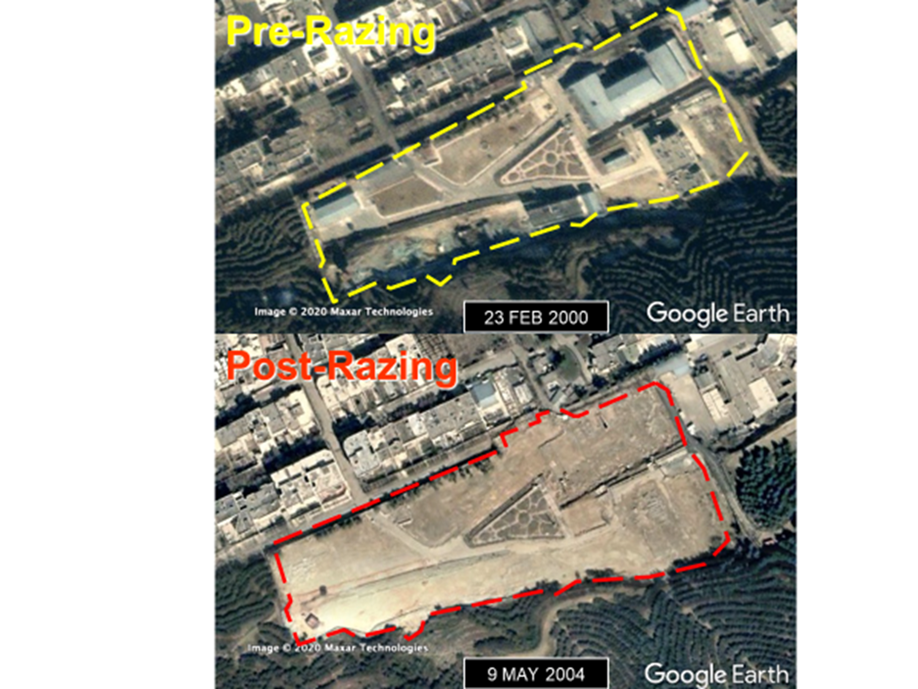
Figure 1. Before and after pictures from 2000 (above) and 2004 (below) show the extent of razing and sanitization that took place at Lavisan-Shian.
The metal disc at Lavisan was apparently part of Iran’s nuclear weapons-related work, detailed in Iran’s Nuclear Archive. Among the files was information about Iran’s work on producing uranium deuteride (UD3) for a neutron initiator used in nuclear weapons. The information detailed procedures Tehran used to make uranium deuteride, including drilling into a piece of uranium metal. 8
The IAEA’s assessment of the metal flakes undergoing chemical processing stops short of specifying the achieved or intended chemical product but is consistent with the production of uranium deuteride. Further, the IAEA stated in its June 5, 2020 report that the uranium metal disc had “indications of it undergoing drilling and hydriding..” 9 The statement about “drilling and hydriding” more directly refers to the production of uranium deuteride. 10
The production of UD3 typically involves producing uranium metal chips or shavings from a solid uranium metal piece and combining them under controlled temperatures and pressures with deuterium gas. Iran’s Nuclear Archive contains an image of equipment in a glove box producing the uranium metal flakes (see figure 2); other documents in the archive describe a step-by-step effort to produce UD3, including practicing its synthesis with surrogate materials. The testing of a UD3 neutron initiator is also extensively discussed in the Nuclear Archive, incidentally helping explain the IAEA’s detection in 2015 of uranium from environmental sampling done at the Parchin high explosive chamber, despite Iran’s extensive sanitization efforts. 11
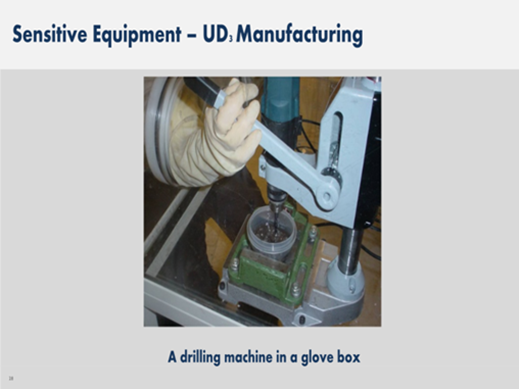
Figure 2. A photo from Iran’s Nuclear Archive, obtained by the media and shared with the Institute, shows a glove box containing a drilling machine, with what appears to be a black object that is likely the uranium metal disc at issue at Lavisan-Shian. Under the Amad Plan, the production of uranium deuteride had a codename, Project 3.20. When the Amad Plan was downsized and reconstituted as a smaller, more disguised effort in late 2003 and early 2004, Project 3.20 was to be closed, but a few of the project staff needed to make the “Source” – a codeword for the uranium deuteride neutron initiator – were slated to continue their activities. 12
Evidence of post-2003 Iranian work on UD3 and neutron initiators includes an Iranian document that surfaced in 2009. The document, dated to 2007, discusses how, although work on neutron sources made progress in the past, it was reduced in scale, leading to a decision to increase that work starting in about 2007, including continuing ongoing work on the production and testing of a UD3 initiator. 13
The IAEA should further explain the safeguards violations at Lavisan, and what it means for the IAEA’s ability to determine the nature of Iran’s nuclear program. Additional follow-up questions include: what happened to the equipment used for making and chemically processing uranium metal flakes? What is the status and purpose of neutron initiator activities conducted after 2003? Like containers from Varamin, other containers at Turquz-Abad may have held equipment and materials from Lavisan-Shian.
Location 3: Tehran Plant, near Varamin
The agency reports new information regarding Location 3, while noting Iran’s refusal to address safeguards violations at the site.
Location 3 is identified in Iran’s Nuclear Archive as the “Tehran Plant,” or what the IAEA calls the Varamin site, which is a nearby town. The site was a former, secret pilot uranium conversion plant under the Amad Plan. 14 The IAEA corroborated archive evidence that Iran may have used the site for “possible use or storage of nuclear material and/or conducting of nuclear-related activities, including research and development activities related to the nuclear fuel cycle. This location may have been used for the processing and conversion of uranium ore, including fluorination, in 2003,” the IAEA added. Iran demolished the site in 2004. In the latest report, the IAEA amplified its earlier statements:
“The Agency assessed that Varamin was an undeclared pilot-scale facility for the processing and milling of uranium ore and conversion into uranium oxide and possibly, at laboratory scale, into UF4 and UF6, used between 1999 and 2003. This location also underwent significant changes after 2003, including the demolition of most buildings, scraping and landscaping that was consistent with sanitisation, as well as the removal of containers.”
The IAEA originally asked for access to the site in January 2020, but Iran refused until August 2020. The IAEA took environmental samples, indicating the presence of undeclared man-made uranium particles.
In its September 2021 report, the IAEA reported more information, linking materials at this site to Turquz-Abad. The IAEA reported that Iran removed containers from the site in 2004 and that “there are indications, supported by the results of the environmental samples analysis, that containers moved from Location 3 were subsequently also present at Location 1 [Turquz-Abad].” The IAEA further reported that the results of the samples from Varamin “would not explain all of the particles identified by the analytical results of the environmental samples taken at Location 1.” This finding is in line with assessments that Turquz-Abad was a storage location for a wide variety of equipment related to Iran’s undeclared nuclear activities. Iran’s subsequent explanations were judged as lacking support or inconsistent with the evidence.
Location 4: Marivan Site
The IAEA was also unsuccessful in resolving safeguards issues at Location 4, or Marivan. The formerly secret Marivan site, near Abadeh, is another Amad Plan facility identified in the Nuclear Archive.15 The IAEA noted in its previous reports that Location 4 “consists of two proximate areas where the Agency found indications that Iran had, in 2003, planned to use and store nuclear material.”
Along with the Varamin site, the IAEA sought access to Marivan in January 2020, refused by Iran until August 2020, when the IAEA took environmental samples that revealed the presence of uranium particles.
In one area (see figures 3 and 4), “where outdoor, conventional explosive testing may have taken place,” the IAEA found “indications relating to the testing of shielding in preparation for the use of neutron detectors in that same area” (see figure 5). In the second area, from July 2019 onwards, “the Agency observed via commercial satellite imagery, activities consistent with efforts to sanitize the area, including the demolition of buildings.”
The IAEA attempted to engage Iran regarding Marivan in September 2021, providing Iran with “graphics based on commercially available satellite imagery that illustrated the activities identified by the Agency as inconsistent with Iran’s statement that there had been no activity at this location between 1994 and 2018.” In a reply, Iran stated, “‘only the mining activities, which were main activities at this location, have been stopped during the said period’ and that the activities observed at the location had involved guards ‘to secure the properties at location.’”
According to the September 2021 IAEA report, the IAEA stated it would contact another member state to seek “clarification and confirmation” in response to information provided by Iran that “included a reference to activities conducted at Location 4 in the past by an organization from another Member State.” The member state responded that “the information provided by Iran had contained ‘no information indicating a link’ between the cooperation provided by the aforementioned organization in Iran, mentioned in the supporting documentation provided by Iran, ‘and the anthropogenic uranium particles found by the Agency.’”
An Institute assessment of satellite imagery of the site found that Iran appears to have conducted further demolition activities following the IAEA’s visit, possibly to stymie future verification activities (see figure 6). 16 In its latest report, the IAEA stated that following its access to the site, it “observed through the analysis of commercially available satellite imagery that the aforementioned bunkers had been removed.”
The IAEA reported in its September 2021 report that in addition to explaining the presence of uranium, Iran must also provide answers regarding “the source of the neutrons that the neutron detectors were to measure” at the location. Iran has only provided unsubstantiated information about activities at Marivan, which the IAEA has dismissed.
The source of the neutrons was likely to have been a uranium deuteride neutron initiator placed at the center of a nuclear weapons high explosive system lacking its fissile material. When the system is detonated, the inward compression from the high explosive would squeeze the surrogate core with the neutron initiator at its center, creating fusion of the deuterium, resulting in a spurt of neutrons. If the core had contained fissile material, or weapons-grade uranium in the Iranian design, the neutrons would have started the chain reaction and the nuclear explosion. This type of test is done near the end of a nuclear weapons development program and is often called a “cold test.”
Despite the evidence, Iran stated in May 2022 that the photographs previously provided by the IAEA of the bunkers at Marivan were “fabricated.” According to the IAEA, “This is despite the photographs being consistent with the Agency’s observations through the analysis of commercially available satellite imagery and visual observations during the complementary access at this location.”
The IAEA further draws a connection between Marivan and Turquz Abad, noting that based on analysis of commercially available satellite imagery, “trucks observed at Marivan and Turquz-Abad between mid-July and mid-August 2018 had similar features,” and that major parts of the Marivan site were demolished right after the IAEA shared its sampling results from Turquz-Abad.
The IAEA concluded, “analysis of all safeguards-relevant information available to the Agency related to ‘Marivan’ is consistent with Iran having conducted explosive experiments with protective shielding in preparation for the use of neutron detectors.”

Figure 3. The Marivan high explosives test site near Abadeh, Iran, as it appeared in 2006, showing the location of the two bunkers and an explosion point that was slated to use the neutron detectors.
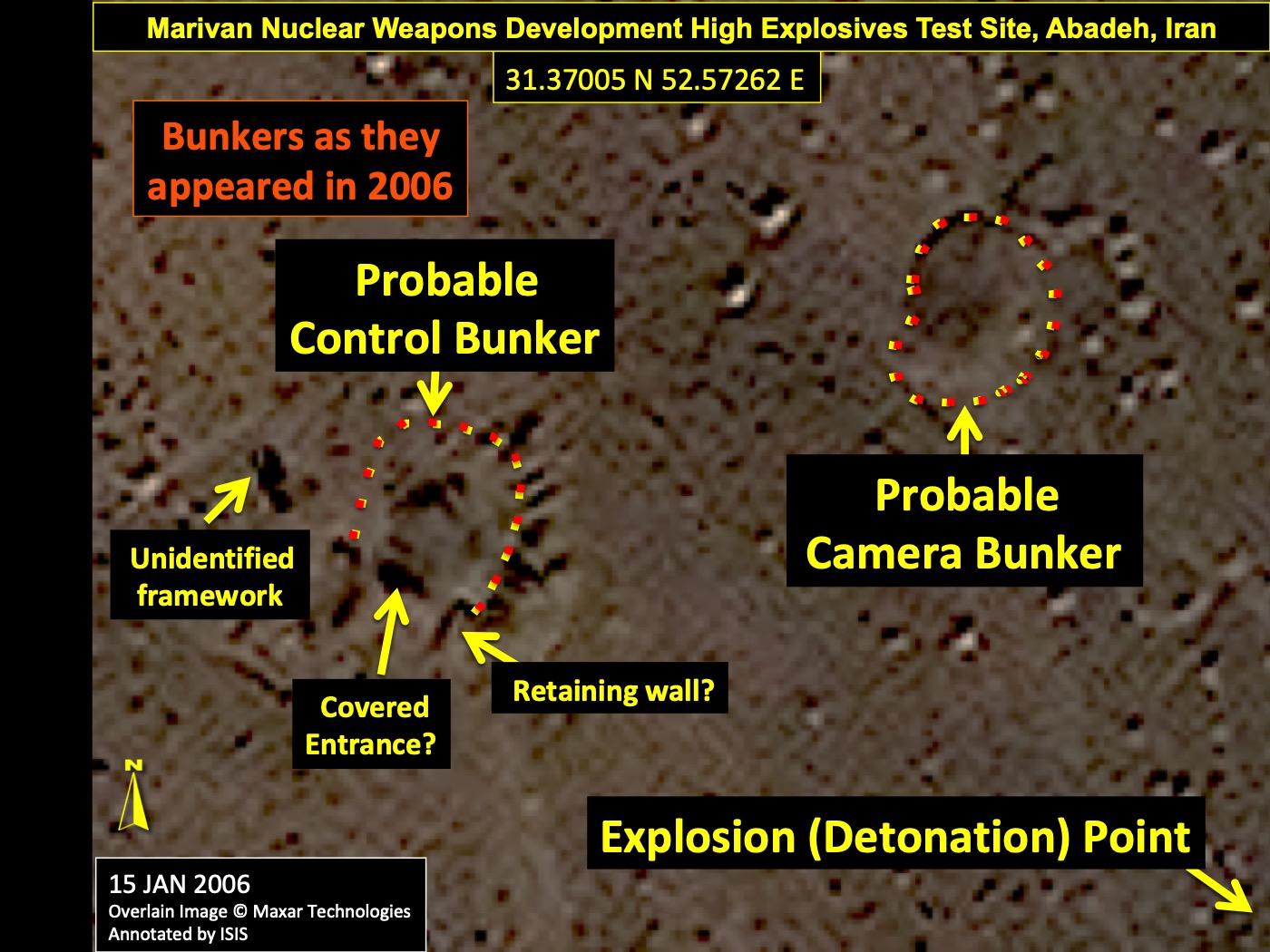
Figure 4. A close-up of the explosive test site’s associated bunkers as they appeared in 2006, the nearest-in-time available high-resolution image to the 2003 tests.
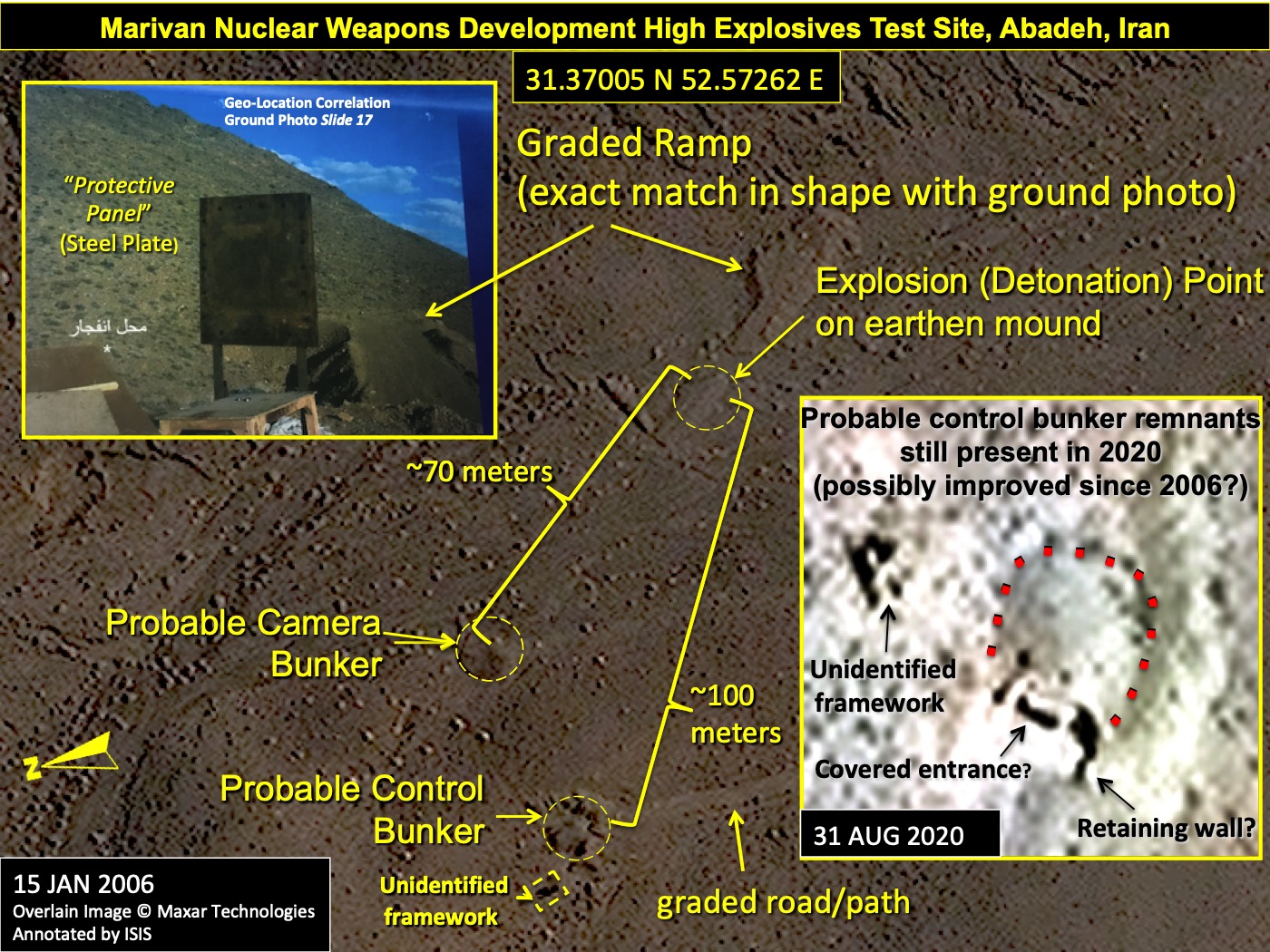

Figure 5. Top image: A 2006 image of the test site at Marivan, with a ground photo inset from the Nuclear Archive, showing shielding material, pre-test. Bottom image: Shielding material post-test.
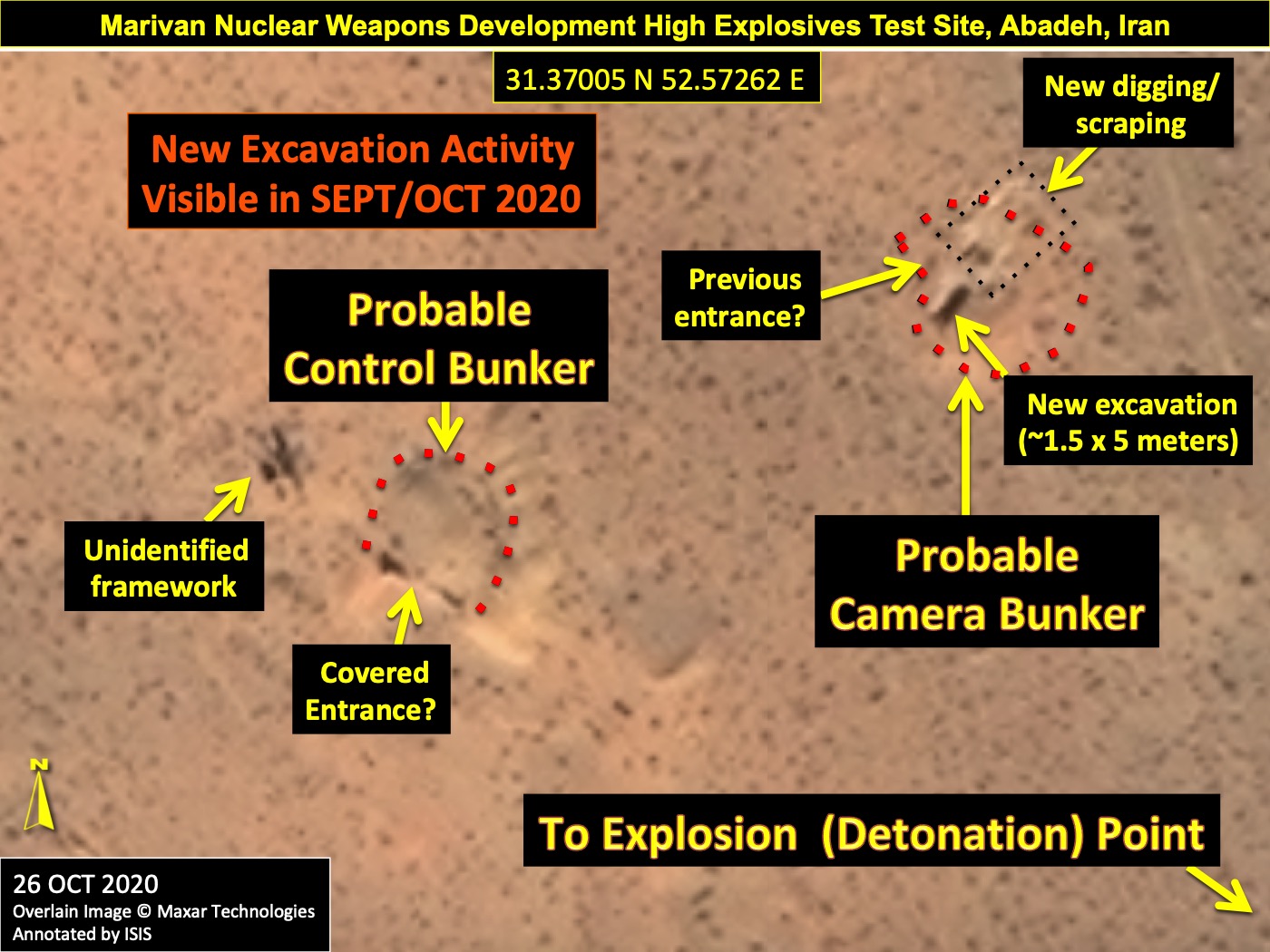
Figure 6. In top image, detected excavation and digging/scraping activity at the probable camera bunker, post-August 31, 2020. In bottom image, the excavation appears partially filled and the probable control bunker appears collapsed as of January 2021.
1. Andrea Stricker is a research fellow at the Foundation for the Defense of Democracies (FDD). ↩
2. For fuller descriptions of these four locations and their relationship to today, see David Albright with Sarah Burkhard and the Good ISIS Team, Iran’s Perilous Pursuit of Nuclear Weapons (Washington, D.C.: Institute for Science and International Security Press, 2021). ↩
3. John Irish and Arshad Mohammed, “Netanyahu, in U.N. Speech, Claims Secret Iranian Nuclear Site,” Reuters, September 27, 2018, https://www.reuters.com/article/us-un-assembly-israel-iran/netanyahu-in-un-speech-claims-secret-iranian-nuclear-site-idUSKCN1M72FZ ↩
4. David Albright, Sarah Burkhard, Olli Heinonen, and Frank Pabian, “Presence of Undeclared Natural Uranium at the Turquz-Abad Nuclear Weaponization Storage Location,” Institute for Science and International Security, November 20, 2019, https://isis-online.org/isis-reports/detail/presence-of-undeclared-natural-uranium-at-the-turquz-abad-nuclear-weaponiza ↩
5. Iran’s Perilous Pursuit of Nuclear Weapons. ↩
6. Iran’s Perilous Pursuit of Nuclear Weapons. ↩
7. David Albright, Paul Brannan, and Andrea Stricker, “The Physics Research Center and Iran’s Parallel Military Nuclear Program,” Institute for Science and International Security, November 20, 2019, https://isis-online.org/uploads/isis-reports/documents/PHRC_report_23February2012.pdf. See also: Iran’s Perilous Pursuit of Nuclear Weapons. ↩
8. “Neutron Source: Iran’s Uranium Deuteride Neutron Initiator,” Institute for Science and International Security, May 13, 2019, https://isis-online.org/isis-reports/detail/neutron-source-irans-uranium-deuteride-neutron-initiator-1/ See also: Iran’s Perilous Pursuit of Nuclear Weapons.↩
9. IAEA Director General, “Verification and Monitoring in the Islamic Republic of Iran in Light of United Nations Security Council resolution 2231 (2015),” GOV/2020/26, June 5, 2020, https://isis-online.org/uploads/iaea-reports/documents/IAEA_Iran_Quarterly_Safeguards_Report_June_2020_.pdf↩
10. “Neutron Source: Iran’s Uranium Deuteride Neutron Initiator.” ↩
11. David Albright, Sarah Burkhard, Olli Heinonen, and Frank Pabian, “New Information about the Parchin Site: What the Atomic Archive Reveals About Iran’s Past Nuclear Weapons Related High Explosive Work at the Parchin High Explosive Test Site,” Institute for Science and International Security, October 23, 2018, http://isis-online.org/isis-reports/detail/new-information-about-the-parchin-site ↩
12. Memorandum, Statement of Mohsen Fakhrizadeh, October 25, 2003. From Nuclear Archive. See: Iran’s Perilous Pursuit of Nuclear Weapons.↩
13. “New Document Reopens Question on Whether Iran’s Nuclear Weaponization Work Continued Past 2003, Institute for Science and International Security, October 23, 2018, https://isis-online.org/isis-reports/detail/new-document-reopens-question-on-whether-irans-nuclear-weaponization-work-c/8; Farsi and English versions of the document are available at: http://isis-online.org/isis-reports/detail/farsi-and-english-versions-of-document-on-neutron-initiator/.↩
14. Iran’s Perilous Pursuit of Nuclear Weapons, Chapters 8 and 12; and David Albright, Sarah Burkhard, and Frank Pabian, “The Amad Plan Pilot Uranium Conversion Site, Which Iran Denies Ever Existed,” Institute for Science and International Security, November 9, 2020, https://isis-online.org/isis-reports/detail/the-amad-plan-pilot-uranium-conversion-site/8.< ↩
15. David Albright, Sarah Burkhard, and Frank Pabian, “Abadeh is Marivan: A Key, Former Secret Nuclear Weapons Development Test Site,” Institute for Science and International Security, November 18, 2020, https://isis-online.org/isis-reports/detail/abadeh-is-marivan-irans-former-secret-nuclear-weapons-development-test-site”↩
16. David Albright and Sarah Burkhard, “More Demolition at the Marivan Former Nuclear Weapons Development Site,” Institute for Science and International Security, March 1, 2022, Institute for Science and International Security, November 9, 2020, https://isis-online.org/isis-reports/detail/more-demolition-at-the-marivan-former-nuclear-weapons-development-site. ↩

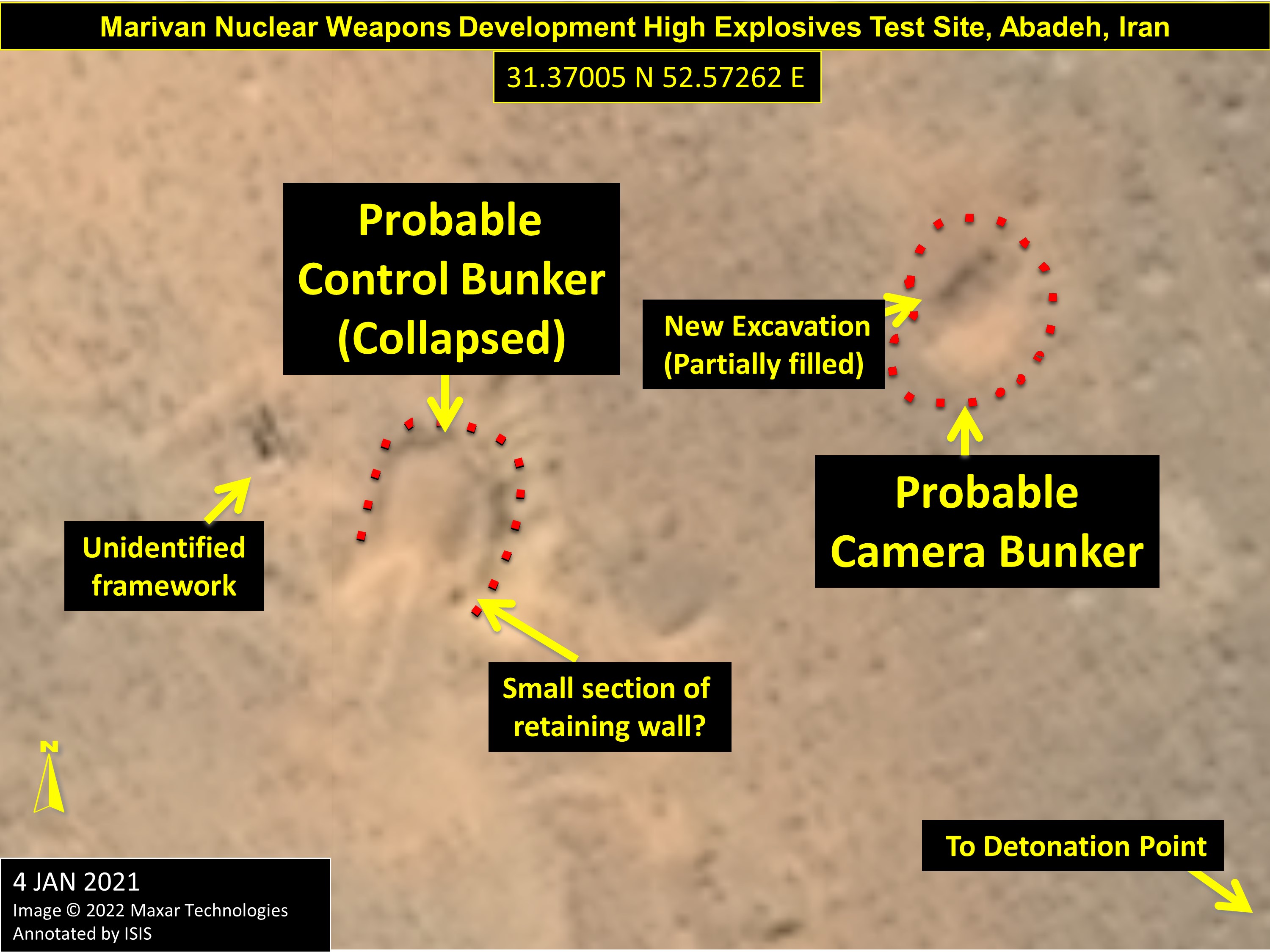
 twitter
twitter